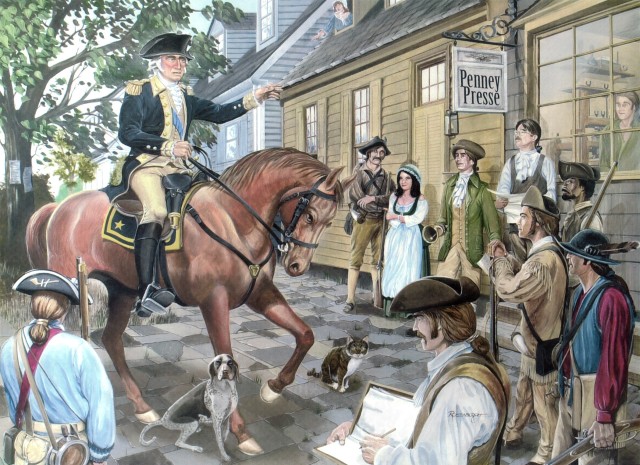WASHINGTON (Army News Service, June 5, 2014) -- Before the American colonies even made their declaration of independence, the Second Continental Congress gathered together in Philadelphia 238 years ago to formally create a standing Army.
The next day, June 15, 1775, Congress chose George Washington, a Virginian, to be commander in chief. Washington's military experience was perhaps greater than that of any other American, and he came from the largest and arguably the most important of the southern colonies. His impressive appearance, quiet and confident manner, and good work in the military committees of Congress had impressed his compatriots.
Washington himself recognized, when he accepted the command, that he lacked the requisite experience and knowledge in handling large groups of men. His entire military experience had been in frontier warfare during the French and Indian War, though he had commanded a brigade of troops from several colonies during the capture of Fort Duquesne. He was the only native-born American up to that time to command a force that size. Experience gained as a political leader in his native Virginia and in directing the business affairs of his large plantation at Mount Vernon also stood him in good stead.
Washington brought to command traits of character and abilities as a leader that in the end more than compensated for his lack of European military experience. Among these qualities were a determination and a steadfastness of purpose rooted in an unshakable conviction of the righteousness of the American cause, a scrupulous sense of honor and duty, and a dignity that inspired respect and confidence in those around him. Conscious of his own defects, he was always willing to profit by experience.
The Army of which Washington formally took command on July 3, 1775, he described as "a mixed multitude of people under very little discipline, order or government." Out of this mixed multitude, Washington set out to create an Army shaped in large part on the British image. Basing his observations on his experience with British regulars during the French and Indian War, he wrote: "Discipline is the soul of an army. It makes small numbers formidable; procures success to the weak and esteem to all."
Washington and his staff made strenuous efforts to halt the random comings and goings of officers and men and to institute regular roll calls and strength returns. Suspicious of the "leveling" tendencies of the New Englanders, Washington made the distinction between officers and enlisted men more rigid. He introduced various punishments such as the lash, pillory, wooden horse, and drumming out of camp along with courts-martials.
While establishing discipline in the existing army, Washington had at the same time to form a new one enlisted directly in the Continental service. Out of conferences with a congressional committee that visited camp in September 1775 emerged a plan for such an army, composed of 26 regiments of infantry of 728 men each, plus one regiment of riflemen and one of artillerymen. In all, 20,372 men became uniformly paid, supplied, and administered by the Continental Congress and enlisted to the end of the year 1776. The general by his choice received no pay throughout the Revolution.
It was a decent plan on paper; but Washington soon found he could not carry it out. Both officers and men resisted a reorganization that cut across the lines of the locally organized units in which they were accustomed to serve. The men saw as their first obligation their families and farms at home, and they were reluctant to re-enlist for another year's service.
Washington also had to maintain the siege of Boston and overcome his deficiencies in supply. In these efforts he was more successful. Congress and the individual colonies sponsored voyages to the West Indies, where the French and Dutch had conveniently exported quantities of war materials. Washington put some of his troops on board ship and with an improvised navy succeeded in capturing numerous British supply ships.
He sent Col. Henry Knox, later to be his chief of Artillery, to Forts Ticonderoga; and Knox in the winter of 1775-1776. Knox brought some 50 pieces of captured cannon to Cambridge, Mass., over poor or nonexistent roads in icebound New York and New England. By March 1776, despite deficiencies in the number of continentals, Washington was ready to close in on Boston.
On March 4, 1776, he moved onto Dorchester Heights and emplaced his newly acquired artillery in position to menace the city; a few days later he fortified Nook's Hill, standing still closer in. On March 17 the British moved out.
Maj. Gen. William Howe, who succeeded Maj. Gen. Thomas Gage in command, had concluded long since that Boston was a poor strategic base and intended to stay only until the transports arrived to take his army to Halifax in Nova Scotia to regroup and await reinforcements.
Nevertheless, Washington's maneuvers hastened his departure, and the reoccupation of Boston was an important psychological victory for the Americans, balancing the disappointments of the Canadian campaign. The stores of cannon and ammunition the British were forced to leave behind were a welcome addition to the meager American arsenal and helped win the revolution.
Related Links:
Continental Congress authorizes Army


Social Sharing